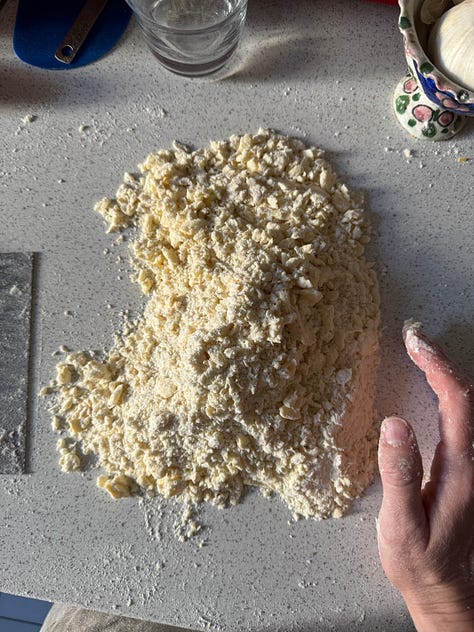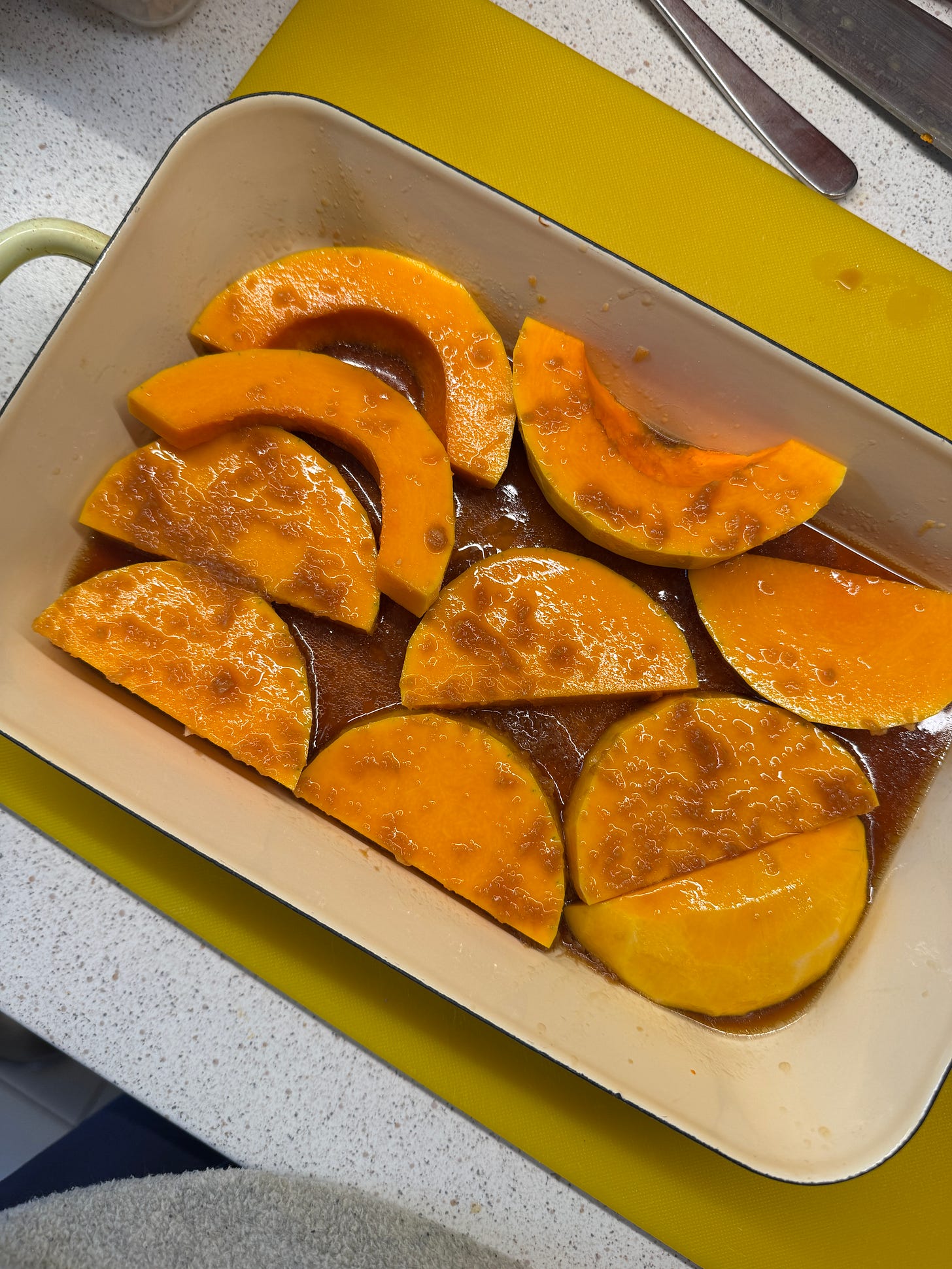We left Berlin in early November, and although I’m glad to have moved on, there are things that I’ll miss: The rye fields planted every year along the Mauerweg, with flaming poppies that grew through the young green blades. Going with my son to the Sophien Friedhof on Bergstraße to look for red squirrels, or watching the solitary heron dive for goldfish in Weinbergspark. Visiting the Trödelmarkt at the Keramik Museum in Charlottenburg, an annual ritual. The pizza at Stranero, the sesame-roasted-carrot sandwich at Rocket + Basil, and virtually anything from Canal, but particularly the salted-caramel eclair, the chausson aux pommes, and the peach olive oil ice cream.
After I wrote that we were leaving, I received several messages from former customers telling me what they missed from my bakery. Our seasonal galettes came up often. So, for my Berlin swan song, I’m sharing the recipe for one of the galettes we offered in autumn: soy-roasted butternut squash and sesame. The sweet butternut is doused in a rich blend of soy sauce, sesame oil, rice vinegar, ginger, and garlic, and roasted until soft. It’s then laid on a thick bed of mascarpone mixed with yogurt, scallion, and soy sauce. Finally, the whole lot is wrapped in sesame seed–laced shortcrust pastry. You can make the pastry in the food processor—combine everything except the milk in the bowl, blitz until sandy, then add the milk to bring it together— but it’s especially lovely when it’s done by hand. You can make the galette without the egg pancake, but you’ll run the risk of the dreaded soggy bottom, and it won’t reheat quite as nicely. I serve the tart just warm or at room temperature, with a steamed green vegetable or simple salad. The pastry makes enough for two large galettes. Either store the extra one in the fridge (where it’ll keep for three to four days), put it in the freezer, or double the filling quantities and make two!
Soy-roasted butternut squash and sesame galette
Serves 4
For the pastry:
250 grams all-purpose flour
150 grams unsalted butter, cold and cubed
1 egg
1 teaspoon salt
1 tablespoon cold whole milk
For the soy-roasted butternut squash:
400 grams butternut squash, peeled, deseeded, and sliced into 1-centimeter slices
1 ½ tablespoons soy sauce
1 tablespoon sesame oil
1 tablespoon maple syrup or honey
½ tablespoon rice vinegar
3 centimeter piece of fresh ginger, peeled and grated finely
1 large clove of garlic, grated
¼ cup water
For the egg pancake:
1 egg whisked until smooth
For the mascarpone:
100 grams mascarpone
50 grams full-fat yogurt
2 scallions, finely chopped
1 tablespoon soy sauce
For rolling and finishing the pastry:
2 tablespoons black sesame seeds
1 egg whisked until smooth for egg wash
Equipment:
Pastry cutter
Rolling pin
Pastry brush
Tip the all-purpose flour onto a clean work surface and make a well in the middle. Add the butter, egg, and salt into the well. Use a pastry cutter to cut the butter, egg, and salt through the flour. Keep bringing it all back together into a pile, then start cutting through again. Eventually, the mixture will start to look quite sandy in texture. Add the milk and continue to cut through the mixture until it forms a dough. Use the heel of your hand to knead the mixture five times. Bring it all back together, form it into a ball, then divide in two. Flatten each half into a disk and wrap them separately in cling film, then place in the fridge for at least four hours, or preferably overnight.



Preheat the oven to 220ºC. Use a small whisk to mix the soy sauce, sesame oil, maple syrup, rice vinegar, ginger, garlic, and water together in a jug. Place the sliced butternut squash in a small roasting tin (I use a 29-by-18-centimeter roasting pan), then pour the soy-sauce mixture over the top. Toss the butternut squash in the sauce, then roast in the oven for 20 minutes, or until the butternut squash is soft. Allow to cool.
While the squash roasts, heat a small (ideally 20–22 centimeters in diameter) nonstick frying pan sprayed with a little cooking spray, or greased with a little butter, over a medium heat. Pour in the egg and coat the bottom of the frying pan. Turn the heat down to medium-low, cover, and cook for a minute or two, or until the egg pancake is cooked through. Gently use a spatula to peel the pancake off the pan and lay it on a plate to cool.
In a bowl, stir together the mascarpone, yogurt, scallions, and soy sauce until smooth. Set aside in the fridge.
Transfer the black sesame seeds to a clean surface. Remove one of the pastry disks from the fridge and unwrap it. Lay it on top of the sesame seeds and dust the surface of the pastry with flour. Use a rolling pin to roll the pastry over the top of the sesame seeds so they embed in the underside of the pastry. Dust the surface of the pastry with flour as needed, and roll it out until it’s 35 centimeters in diameter. At this point, you might find it easier to transfer the pastry to a sheet of baking parchment to assemble the galette.



Preheat the oven to 220ºC.
Lay the egg pancake on top of the pastry. Spread the mascarpone mixture over the top (it’s OK to spread it beyond the edge of the pancake a bit). Lay the cooled butternut squash over the top, and scrape any remaining sauce from the pan to spread on top. Lift the edges of the pastry and lay them down around the outer edges of the squash until you’ve fully enclosed the filling. Use a cake lifter to transfer the galette to a baking tray (lined with baking parchment, if you haven’t already assembled the galette on a sheet). Brush the surface of the pastry with the egg wash, then bake in the center of the oven for 30 minutes, or until golden brown. Transfer to a cooling rack and serve just warm or at room temperature. The galette can be reheated in a 200ºC oven for 15 minutes.








The magic and gift of a swan song. Thank you BIBB ♥️
I dream of sitting down with you and a plate of galettes and The Buns - wishing you even more sunshine in the new as there was in the old xx